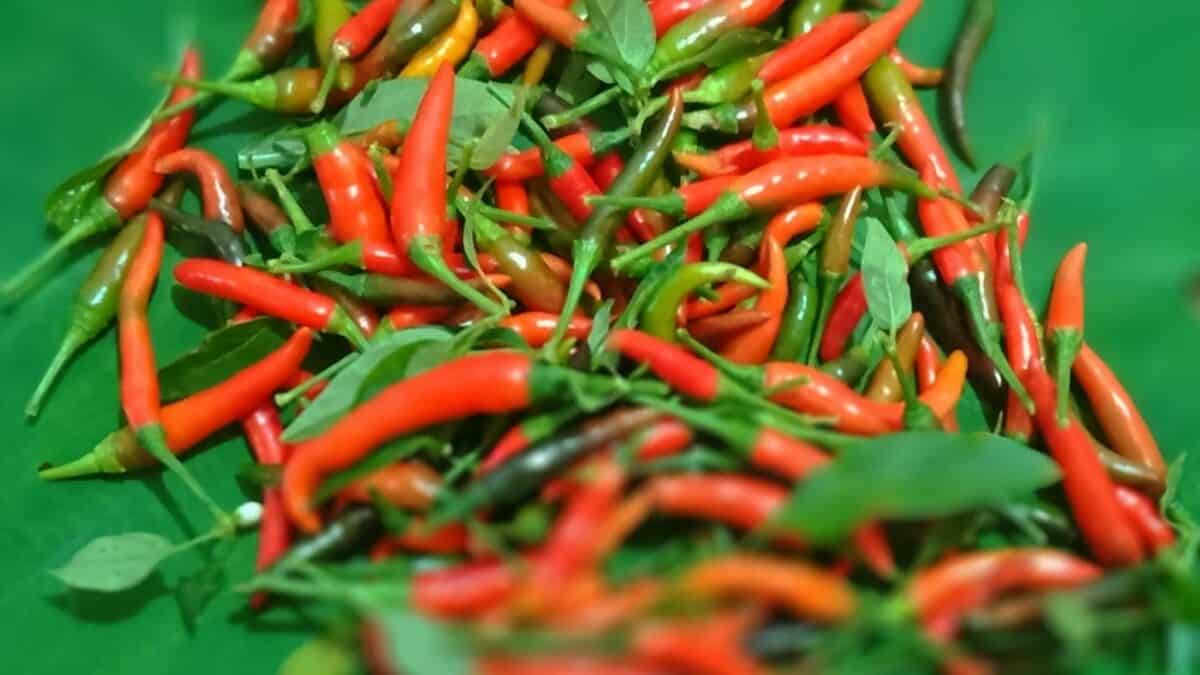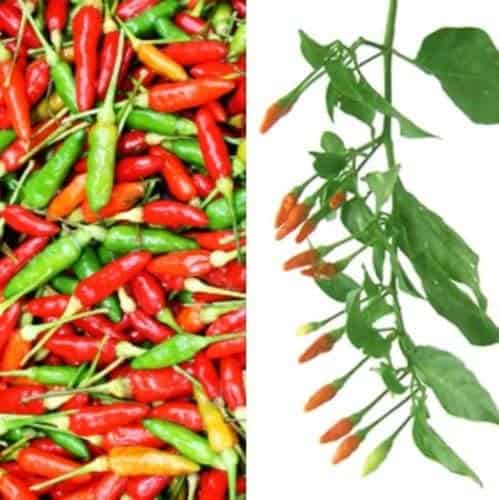Siling Labuyo: The VERY Hot Filipino Chili Pepper
Siling Labuyo is a small chili pepper from the Capsicum frutescens genus that was cultivated in the Philippines after the Columbian Exchange.
It is characterized by its triangular fruits which grow pointing upwards. The fruits and leaves of Siling Labuyo are used in traditional Philippine cuisine.
The fruit is pungent, with a Scoville Scale heat rating of 80,000 to 100,000.

The cultivar name Siling Labuyo is Tagalog, and means “wild chili.” It is also known simply as labuyo or labuyo chili.
Siling Labuyo is sometimes also referred to as Filipino bird’s eye, to differentiate it from the Thai bird’s eye.
It is one of the endangered heritage foods of the Philippines, listed in the Ark of Taste international catalog and was listed in the Guinness Book of World Records as hottest pepper.
Other hotter varieties of chili have since been discovered.
They are thin peppers that grow to up to 0.70 inch (1.78 cm) long.

Check out our new cookbook
Bitemybun's family recipes with complete meal planner and recipe guide.
Try it out for free with Kindle Unlimited:
Read for freeIn this post we'll cover:
- 1 How to know when siling labuyo is ripe?
- 2 What does Siling Labuyo taste like?
- 3 Best Siling Labuyo to buy
- 4 What’s the difference between Siling Labuyo and Siling Haba?
- 5 What’s the difference between Siling Labuyo and ghost pepper?
- 6 Popular Siling Labuyo pairings
- 7 Is Siling Labuyo healthy?
- 8 Conclusion
How to know when siling labuyo is ripe?
Ripe Siling Labuyo peppers will be a deep red color. You can also tell by the sound it makes when you squeeze it; if it’s ripe, it will make a popping sound.
The plant grows well in pots and can reach up to 3 feet (0.91 m) high. It prefers warm climates and does best in full sun.
Siling Labuyo can be used in any dish where you want a little bit of heat. It is often used as a condiment, added to dishes at the table. It can also be used in cooking, for example in stews or stir-fries.
What does Siling Labuyo taste like?
Siling Labuyo has a subtle earthy flavor that is overpowered by its pungent, searing heat. The heat level can vary depending on the peppers, with some being much hotter than others.
The Siling Labuyo chili pepper is significantly spicier than the jalapeño pepper and can be up to 40 times hotter, depending on the individual peppers chosen. The Scoville Scale heat rating of Jalapeno is between 2,000 and 8,000 and siling labuyo between 80,000 to 100,000.
Best Siling Labuyo to buy
Siling labuyo fresh from the market is always best, but not all of us can go to a Filipino market.
You can buy seeds anywhere in the world, like these from Floralys so you can grow them yourself:

What’s the difference between Siling Labuyo and Siling Haba?
Siling Labuyo and Siling Haba are both varieties of chili peppers that belong to the Capsicum frutescens species. They are similar in appearance, small, thin peppers that grow pointing upwards. The main difference between the two is their heat level; Siling Labuyo is significantly hotter than Siling Haba and it’s red where haba is green.
What’s the difference between Siling Labuyo and ghost pepper?
The ghost pepper, also known as the Bhut Jolokia, is a chili pepper that was cultivated in India. It is one of the hottest peppers in the world, with a Scoville Scale heat rating of 1,041,427. The ghost pepper is significantly hotter than Siling Labuyo and has a somewhat different flavor profile.
Popular Siling Labuyo pairings
Siling Labuyo goes well with other strong flavors. It is often used as a condiment, added to dishes at the table. It can also be used in cooking, for example in stews or stir-fries. Some popular pairings include:
– Tomatoes
– Onions
– Garlic
– Vinegar
– Soy sauce
– Fish sauce
– Coconut milk
– Beef
– Chicken
– Pork
– shrimp
– squid
Is Siling Labuyo healthy?
Siling Labuyo is a good source of vitamins A and C. It also contains capsaicin, which has a number of potential health benefits. These include pain relief, reduced inflammation, and improved blood sugar control. However, it’s important to keep in mind that the peppers are very hot and should be used in moderation.
Conclusion
This pepper is very hot but used in so many Filipino dishes for its unique and strong taste.
Check out our new cookbook
Bitemybun's family recipes with complete meal planner and recipe guide.
Try it out for free with Kindle Unlimited:
Read for freeJoost Nusselder, the founder of Bite My Bun is a content marketer, dad and loves trying out new food with Japanese food at the heart of his passion, and together with his team he's been creating in-depth blog articles since 2016 to help loyal readers with recipes and cooking tips.
